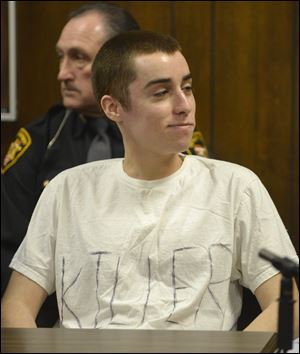
Chardon shooting gunman appeals life sentence
3/26/2014
T.J. Lane smirks as he listens to the judge during his sentencing in Chardon, Ohio in March, 2013.
CHARDON, Ohio — An attorney for a teenager who pleaded guilty to killing three students in a high school cafeteria asked an appeals court today to toss out his sentence of life without parole because he was 17 at the time of the shooting.
A prosecutor told the judges that Ohio law makes it clear that older teens charged with serious crimes should be tried in adult court.
T.J. Lane’s attorney is challenging a state law that allowed his case to be transferred from juvenile court to adult court, a statute also being contested in an unrelated case pending before the Ohio Supreme Court involving a 16-year-old sent to prison.
The law requires the transfer to adult court if a suspect is 16 or 17 and accused of one of the most severe offenses, and there is probable cause to believe he or she committed the crime.
Lane was waiting for a bus to his alternative school in February 2012 when he opened fire at Chardon High School, east of Cleveland. Three students died and three others were wounded.
The hearing took place inside a courtroom where a smirking Lane wore a T-shirt with “killer” scrawled across it and gestured obscenely toward the victims’ families during his sentencing. He wasn’t present today.
Lane, 19, could be brought back to the same courtroom if the courts decide he should be resentenced. It could take several months for the appeals court to decide. Because Lane was a juvenile, he is ineligible for the death penalty.
Lane’s attorney, Michael Partlow, argued that juvenile judges have more leeway with younger teens. “What is the difference between a 15-year-old and a 17-year-old? He is still not an adult,” Partlow said.
Geauga County Prosecutor James Flaiz countered that several rulings have upheld the state law allowing juveniles to be sent to adult court. He said the law is intended so that a 17-year-old can’t shoot someone in the head and be set free when he turns 21.
The Office of the Ohio Public Defender is aware of four people in Ohio, including Lane, serving life without parole for slayings that occurred when they were juveniles, assistant public defender Stephen Hardwick said.
As of 2012, there were about 2,500 people in the U.S. serving life sentences for homicides that occurred when they were juveniles, but the current number is difficult to track because a U.S. Supreme Court ruling that year raised the possibility that hundreds of those sentences may be called into question, said Marsha Levick, chief counsel for the Philadelphia-based nonprofit Juvenile Law Center.
Giving juveniles life terms without parole “means that we’re making these decisions on Day One of sentencing about who Lane or any other juvenile will be 30, 40, 50 years from now,” Levick said. “And it’s almost impossible to make that decision or to know who he will become as an adult.”
Lane’s attorney also argued Wednesday that he should be resentenced after a recent Ohio Supreme Court decision overturned a life-without-parole sentence for Eric Long, who along with two adult defendants was convicted in two slayings in the Cincinnati area when Long was 17.
The high court ruled that youth must be considered as a mitigating factor and the record must reflect that the court did so. The ruling said a trial court must reconsider Long’s sentence, though it doesn’t block him from being sentenced again to life without parole.
Partlow argued that the judge who sentenced Lane never formally brought up his age. The prosecutor disagreed, saying age was not ignored during the process.